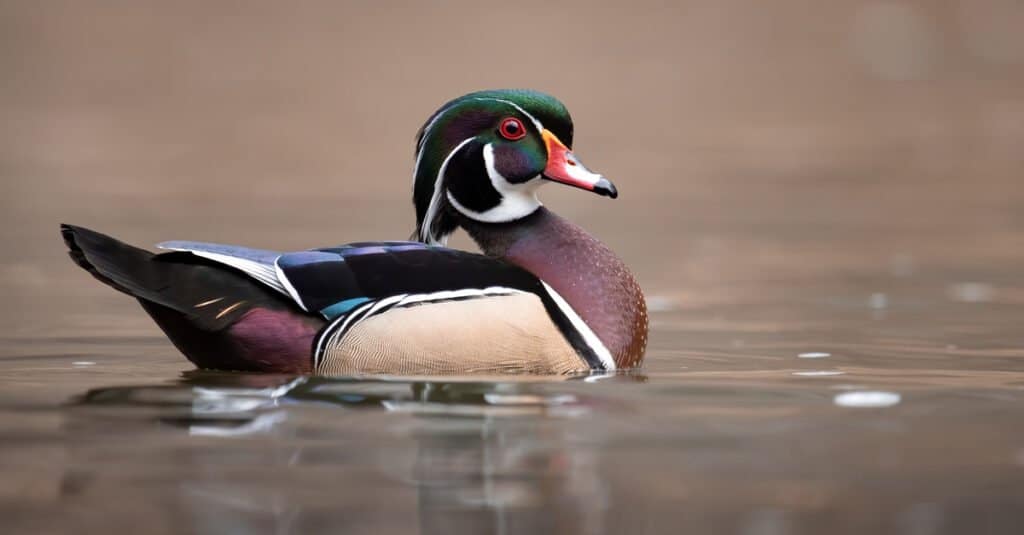Wood ducks and mallards are both unique breeds of ducks. Wood ducks, also known as Carolina ducks, are perching ducks found in North America. Mallards, commonly known as wild duck, is a species of dabbling duck that breeds throughout temperate and subtropical Eurasia, the Americas, and North Africa.
Both species belong to the family Anatidae and have a striking resemblance, making it difficult to discern between them, especially in terms of plumage colorations. Below are fundamental differences between a wood duck and a mallard to help you differentiate the two.
Comparing Wood Duck vs Mallard

| Key Differences | Wood Duck | Mallard |
|---|---|---|
| Size | -Length 19-21 inches (47 to 54 cm) -Wingspan 26 to 29 inches (66 to 73 cm) -Weight 0.996-1.9 pounds (454-862 g) | -Length 20-26 inches (50-65 cm) -Wingspan 32-39 inches (81-98 cm) -Weight 1.5-3.5 pounds (0.7-1.6 kg) |
| Appearance | Multicolored plumage, whitish throat, and a boxy crested head | Prominent dark with a glossy bottle-green head and bright yellow bills, black rears, gray body, and brown breasts |
| Category | Perching ducks | Dabbling ducks |
| Distribution | Found in the United States and some parts of Canada | Commonly found in many places, including North Africa, Eurasia, and the Americas |
| Habitat | Prefer a mix of water habitats and forests | Live in numerous habitats, but prefer living in ponds, lakes, rivers, and marshes. |
| Diet | They mainly feed on aquatic plants, and they only turn to other food sources when aquatic food is not available. | Mainly eat crustaceans, insects, gastropods, worms, and plant matter |
| Egg production | Lay between 7 to 15 white-tan eggs | Lay between 8 to 13 creamy white to greenish-buff eggs |
| Vocalizations | Produce whistle and drawn-out squeal sounds | Produce quack sound |
| Conservation status | The wood duck population faced a severe decline in the late 19th century | Mallards have always been of “least concern” since the beginning of time |
The Key Differences Between a Wood Duck and a Mallard
The key differences between a wood duck and a mallard are their appearance, distribution, category, and conservation status.
Although the two species are so much alike, wood ducks have a distinct multicolored plumage, making them one of the most colorful North American waterfowls. In contrast, mallards have unique gray bodies and prominent iridescent-green heads with bright yellow bills. Their sizes differ as well. Mallards are heavier than wood ducks.
Let’s examine all these differences in more detail to help you better understand the two species.
Wood Duck vs Mallard: Size

The mallard’s weight ranges from 1.5 to 3.5 pounds.
©Jeffry Weymier/Shutterstock.com
The wood duck is medium, typically weighing between 0.996 to 1.9 pounds (454-862 g). It measures approximately 19 to 21 inches (47 to 54 cm) with a wingspan of between 26 to 29 inches (66 to 73 cm).
The mallard is slightly heavier than a wood duck. A typical adult is about 20-26 inches (50-65 cm) in length with a wingspan of between 32-39 inches (81-98 cm). The mallard’s weight ranges from 1.5-3.5 pounds (0.7-1.6 kg).
Wood Duck vs Mallard: Appearance

Both male and female wood ducks have crested heads.
©Rudolf Ernst/Shutterstock.com
Adult male wood ducks have spectacular multicolored iridescent plumage and red eyes, with prominent white flares on their thin necks. Mature female wood ducks have a white eye-ring with a whitish throat and are less colorful than males. Both sexes have crested heads.
Mallard ducks have gray bodies, prominent iridescent-green heads, bright yellow bills, and a white-bordered section on their wings. Females have brown-speckled plumage, while males mainly have purple patches on their wings.
Wood Duck vs Mallard: Category
As mentioned earlier, wood ducks are classified as perching ducks, one of the species of order Anseriformes, family Anatidae that typically inhabit the woodlands, nest in cavities in trees close to water, and use their long-clawed toes to perch on branches.
Mallards belong to the dabbling ducks category, a type of shallow water duck that mainly feed along the water surface or by tipping their heads into the water to graze on aquatic plants, insects, larvae, and worms, among others.
Wood Duck vs Mallard: Distribution
Compared to wood ducks, mallards are widely distributed worldwide, including in North Africa, New Zealand, Eurasia, the Americas, Australia, Brazil, and Uruguay, among many others. Wood ducks are usually spotted only in some parts of the United States and Canada.
Wood Duck vs Mallard: Habitat

Wood ducks breed in wooded swamps, shallow lakes, ponds, and nest in the holes of trees.
©Harry Collins Photography/Shutterstock.com
Mallards live in a wide range of habitats and climates but mostly prefer inhabiting lakes, rivers, ponds, marshes, and open sea within sight of the coastline. Mallards also survive well in coastal habitats like residential backyards and Suburban parks. On the contrary, wood ducks are found in a mix of water habitats and forests. Wood ducks breed in wooded swamps, shallow lakes, ponds, and marshes and nest in the holes of trees.
Wood Duck vs Mallard: Diet
Both species are omnivores. Wood ducks primarily feed on aquatic plants but may turn to arthropods, insects, fruits, and seeds, when marine food is unavailable. Mallards mainly derive nutrients and energy from crustaceans, worms, insects, gastropods, and a wide variety of seeds and plant matter.
Wood Duck vs Mallard: Egg Production

Female mallards lay approximately 8 to 13 creamy white to greenish-buff eggs per clutch.
©iStock.com/MikeLane45
Female wood ducks lay between 7 to 15 white-tan eggs that take about thirty days to hatch. Wood ducklings are released into the wild when 40-45 days old and can fly at about 60 days. Female mallards lay approximately 8 to 13 creamy white to greenish-buff eggs per clutch that incubate for an average of 27-28 days. Mallard ducklings usually fledge by the time they reach 50 days of age.
Wood Duck vs Mallard: Vocalizations
Male wood ducks utter a rising whistle call, jeeeee, while females make a quick cr-r-ek cr-e-ek alarm call and a drawn-out, rising squeal, do weep do weep sound when flushed. Female mallards are famous for their “quack” sounds, whereas males give a quieter, rasping, one- or two-noted call.
Wood Duck vs Mallard: Conservation Status
The wood duck population suffered a serious decline in the late 19th century due to severe habitat loss and excessive human hunting for meat and plumage. Wood ducks had virtually disappeared from most of their former range by the beginning of the 20th century.
The Migratory Bird Treaty was formed in 1916, and the U.S. Migratory Bird Treaty Act of 1918 was enacted in response to the severe decline of the wood ducks, and the populations began to recover slowly. On the other hand, mallards never went into the danger zone from the beginning of time.
The photo featured at the top of this post is © Harry Collins Photography/Shutterstock.com
Thank you for reading! Have some feedback for us? Contact the AZ Animals editorial team.






